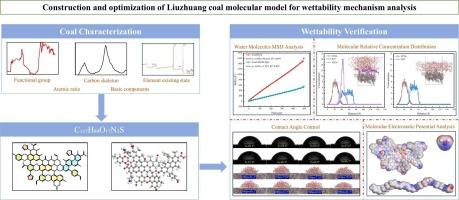刘庄煤润湿机理分子模型的构建与优化
IF 7.5
1区 工程技术
Q2 ENERGY & FUELS
引用次数: 0
摘要
本文采用实验与计算相结合的方法对刘庄煤的分子结构和润湿性进行了研究。FTIR、固态13C NMR和XPS分析鉴定了其官能团和碳骨架结构。建立了分子式为C117H80O17N2S的二维煤分子模型,其可靠性与13C NMR实验结果吻合较好。使用Forcite和DMol3模块进一步进行三维几何优化,显著降低了总能量,增强了结构稳定性。静电电位分析表明,其表面电位范围为-0.08382 ~ +0.106 a.u,亲水性区域稀疏,表明其内在润湿性较差。分子动力学模拟表明,表面活性剂AEO9的加入可以形成致密的界面层,增强了界面的润湿性和稳定性。均方位移分析表明,水分子的扩散系数从无AEO9时的0.4925 Å2/ps下降到有AEO9时的0.1802 Å2/ps,表明AEO9形成了一个氢键网络,限制了水的流动性,提高了润湿层的密实度。模拟的接触角结果与实验数据吻合良好,证实了模型在捕获润湿行为方面的可靠性。本研究建立了结构精确的煤分子模型,阐明了AEO9改善界面润湿的机理,为有效抑尘剂的设计提供理论支持。本文章由计算机程序翻译,如有差异,请以英文原文为准。

Construction and optimization of Liuzhuang coal molecular model for wettability mechanism analysis
This study investigates the molecular structure and wettability of Liuzhuang coal using integrated experimental and computational approaches. FTIR, solid-state 13C NMR, and XPS analyses were conducted to identify functional groups and carbon skeleton structures. A 2D coal molecular model with the formula C117H80O17N2S was constructed, and its reliability was validated by strong agreement with experimental 13C NMR spectra. Further 3D geometry optimization using the Forcite and DMol3 modules significantly reduced the total energy and enhanced structural stability. Electrostatic potential analysis revealed a surface potential range of –0.08382 to +0.106 a.u., with sparse hydrophilic regions, indicating poor intrinsic wettability. Molecular dynamics simulations demonstrated that the addition of surfactant AEO9 led to the formation of a compact interfacial layer, enhancing both wettability and interfacial stability. Mean square displacement analysis showed that the diffusion coefficient of water molecules decreased from 0.4925 Å2/ps (without AEO9) to 0.1802 Å2/ps (with AEO9), indicating that AEO9 formed a hydrogen-bonding network that restricted water mobility and improved wetting layer compactness. Simulated contact angle results aligned well with experimental data, confirming the model's reliability in capturing wetting behavior. This study establishes a structurally accurate coal molecular model and elucidates the mechanism by which AEO9 improves interfacial wetting, offering theoretical support for the design of effective dust suppressants.
求助全文
通过发布文献求助,成功后即可免费获取论文全文。
去求助
来源期刊

Fuel
工程技术-工程:化工
CiteScore
12.80
自引率
20.30%
发文量
3506
审稿时长
64 days
期刊介绍:
The exploration of energy sources remains a critical matter of study. For the past nine decades, fuel has consistently held the forefront in primary research efforts within the field of energy science. This area of investigation encompasses a wide range of subjects, with a particular emphasis on emerging concerns like environmental factors and pollution.
 求助内容:
求助内容: 应助结果提醒方式:
应助结果提醒方式:


